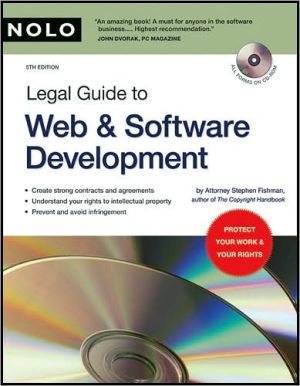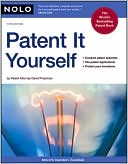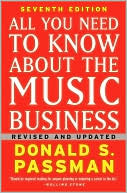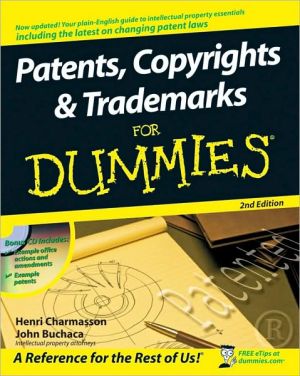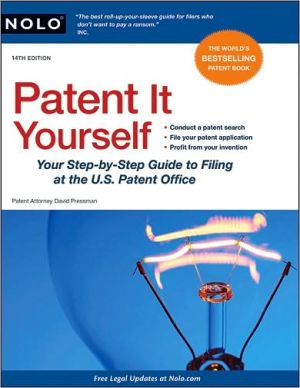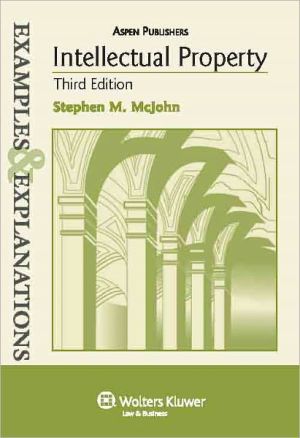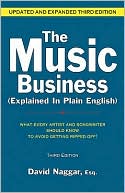A Legal Guide to Web & Software Development
Protect your rights, and your hard work!\ \ The laws covering website and software development are complex and confusing, but if you don't untangle them, it could cost you thousands of dollars in attorneys' fees and lawsuits.\ \ Fortunately, Legal Guide to Web & Software Development decodes this complex area of the law, thoroughly and in reader-friendly English. It also provides contracts, agreements and legal forms on CD-ROM, with step-by-step instructions for filling them out, so you...
Search in google:
Protect your rights, and your hard work!The laws covering website and software development are complex and confusing, but if you don't untangle them, it could cost you thousands of dollars in attorneys' fees and lawsuits.Fortunately, Legal Guide to Web & Software Development decodes this complex area of the law, thoroughly and in reader-friendly English. It also provides contracts, agreements and legal forms on CD-ROM, with step-by-step instructions for filling them out, so you can protect your software and website without paying a lawyer's ransom.Use Legal Guide to Web & Software Development to learn:• what kind of legal protection you need• the strengths and limitations of each type of protection• how to avoid infringement• which provisions you need when drafting an agreement• how to obtain permission to use other people's materialsYou'll find complete, step-by-step instructions to draft:• employment agreements• contractor and consultant agreements• development agreements• license agreementsThe 5th edition of Legal Guide to Web & Software Development is completely update to provide the latest case law and statutory revisions. Entrepreneur Covers every imaginable detail important to such a rapidly growing and intangible medium.
Introduction\ Most websites and software programs combine a variety of materials, including text, graphics, photos, videos, and sounds. Unfortunately, such projects can present difficult and expensive legal problems. These fall into two main categories:\ \ \ \ \ Copyright permissions problems: You may need to obtain permission to use materials protected by copyright, whether it be text, photos, video and film clips, software, or music.\ Obtaining permissions for a Web or software project can involve tracking down many different copyright owners and negotiating licenses to use their material.\ \ \ Publicity/privacy problems: Use of photos, film or video footage, or audio recordings can constitute a breach of the privacy or publicity rights of the people whose likenesses are used. You'll need to consider whether you must obtain privacy releases from persons whose images or voices are used.\ \ \ \ \ \ Obtaining copyright permission and publicity/privacy releases can be a weighty task.\ \ EXAMPLE: The University of the Midwest History Department decides to create a comprehensive website about Columbus's "discovery" of America. Midwest wants to incorporate into the website a variety of preexisting materials about Columbus, including:\ \ \ \ \ text from various articles and books;\ \ \ photos from books, magazines, and other sources;\ \ \ video clips from several television programs;\ \ \ film clips from two theatrical movies about Columbus;\ \ \ music to be used as background to the images and text; and\ \ \ excerpts from a Broadway musical and Italian opera based onColumbus's life.\ \ \ \ \ \ Midwest also plans to create an abbreviated version of the website on a CD-ROM for high school students.\ \ All in all, Midwest intends to incorporate hundreds of separate items into its website and CD-ROM. This sounds like a fine idea for a website and CD-ROM. However, Midwest needs to address and resolve the copyright permissions problem and publicity/privacy problems before it can place its website online.\ \ Other Intellectual Property Concerns\ \ A Web or software developer's main concerns are with copyright and publicity/privacy problems. However, other intellectual property laws may come into play as well. For example:\ \ \ \ \ Third-party software may be patented, as may certain business methods used on the Web. A license must be obtained to use any material protected by a patent.\ \ \ The federal and state trademark laws may protect character names, physical appearance, and costumes; some titles; as well as product names, logos, slogans, and packaging. A developer may have to obtain permission to use a trademark on a website. (See Chapter 10 for an\ overview of trademarks.)\ \ \ Finally, trade secret problems may occur whenever a developer uses or is exposed to any material or information (even a mere idea) that is covered by a confidentiality agreement. A developer must be particularly vigilant about avoiding use of confidential information any\ employee obtained from a prior employer. (See Chapter 7 for a detailed discussion of trade secrets.)\ \ \ \ \ \ There are ways to get around, or at least alleviate, permissions problems. First we'll discuss when a Web or software developer does and does not need to obtain permissions, and second, where and how to get them if they are needed. We'll then review the privacy and publicity issues that arise in Web and software projects.When You Need to Obtain Permission\ Whether or not a Web or software developer needs permission to include any given item in a project depends on:\ \ \ \ \ whether the item is protected by copyright or is in the public domain;\ \ \ whether or not the material is created especially for the project;\ \ \ who created it (employee, independent contractor, or third party); and\ \ \ the extent and nature of the intended use.\ \ \ \ \ \ New Material Created for a Web or Software Project\ \ No copyright permissions problems are normally presented when material is created especially for a Web or software project, whether by the developer's employees or independent contractors.\ \ Under the copyright laws, a developer will automatically own the copyright in materials created in-house by its own employees. As a result, the developer need not obtain permission from its employees to use copyrighted works -- the developer already owns those rights. For example, Midwest University would not need to obtain permission to use text or graphics created by an employee for its website on Columbus. It is wise, however, to have creative employees sign employment agreements transferring whatever ownership rights they might conceivably have to the developer. (See Chapter 14 for a detailed discussion and sample forms.)\ \ When a developer hires an independent contractor to contribute to a Web or software project, it should require the contractor to assign copyright rights to the developer. For example, if Midwest hires a freelance artist to create drawings for its Columbus project, it should have the artist, before commencing work, sign an independent contractor agreement assigning her rights in the drawings to Midwest. (See Chapter 15 for a detailed discussion and \ sample forms.)\ \ Preexisting Materials\ \ The permissions problem raises its ugly head when a developer wishes to use preexisting materials -- that is, materials previously created by nonemployees (or created by employees before they became employees). You can figure out whether permission is required by answering the following two questions:\ \ \ \ \ Is the material in the public domain?\ \ \ Does your intended use of the material constitute a "fair use?"\ \ \ \ \ \ If your answer to both questions is "no," you need permission; otherwise you don't.\ \ Using Copyrighted Material Without Permission\ \ You might be tempted to use copyrighted material without permission if you are unable to locate the copyright owner or simply don't have the time, money, or staff to obtain numerous permissions. If the copyright owner later discovers what you've done, at the very least you will be liable for the reasonable value of the use. If the material is not terribly valuable, this won't amount to much, and the owner will probably accept a small permission fee.\ \ EXAMPLE: Midwest University wants to quote two pages from an old magazine \ article about Columbus. The magazine is out of business and neither the author nor her heirs can be located. Midwest University decides to use the quotation anyway. One year later, Midwest University is contacted by the article's copyright owner. The owner agrees to accept $250 from Midwest for retroactive permission to use the quotation.\ \ On the other hand, if the material is valuable, you could find yourself in big trouble. At the very least, you'll be liable for a substantial permission fee, perhaps more than you'd be able or willing to pay. Instead of settling for a permission fee, the copyright owner might sue you for copyright infringement. In this event, you could face substantial damages. The \ copyright owner you've stolen from could ask the court for the reasonable value of the use and the amount of any economic loss caused by your theft; or, if the material has been registered with the U.S. Copyright Office, the copyright owner could ask for special statutory damages, which can range up to $150,000 (it's up to the judge or jury to decide how much). In some cases, you could even be subject to criminal prosecution. And don't forget, you'll be paying your attorney handsomely, regardless of how the case turns out.\ \ EXAMPLE: Midwest University "borrows" several minutes from the video version of a recent theatrical movie about Columbus and uses it on its website. The film's copyright owners discover the theft and sue Midwest for copyright infringement. They obtain an injunction prohibiting Midwest University from using the pirated footage and ultimately obtain a court judgment against Midwest. They ask the judge to award statutory damages, and, because the judge finds that the infringement was willful and blatant, she awards $50,000 in damages against Midwest.Works That Are in the Public Domain\ The general nature of copyright protection is discussed in Chapter 3. If you haven't read that material, do so now. Copyright protects all original works of authorship. This includes, but is not limited to, writings of all kinds, music, sound recordings, paintings, sculptures and other works of art, photographs, software, film, and video.\ \ Luckily for Web and software developers, however, not every work of authorship ever created is currently protected by copyright -- not by a long shot. A work that is not protected by copyright is said to be in the "public domain"; in effect, it belongs to everybody. Anyone is free to use it without asking permission, but no one can ever own the work again. By using public domain materials, a developer can avoid going through the time, trouble, and expense involved in getting permission to use copyrighted materials.\ \ Following is a brief description of the types of materials that are in the public domain. However, to determine whether a particular work is in the public domain, refer to The Public Domain: How to Find & Use Copyright-Free Writings, Music, Art & More, by Stephen Fishman (Nolo).\ \ Things That Are Never Protected by Copyright\ \ Certain works of authorship and other items are never protected by copyright and are therefore always in the public domain. These include:\ \ \ \ \ Ideas and facts: Because copyright only protects an author's expression, ideas and facts themselves are not protected.\ \ \ Words, names, titles, slogans, and other short phrases: Individual words are always in the public domain, even if they are invented by a particular person. However, these items may be protected under state and federal trademark laws if they are used to identify a product or service. (See Chapter 10.)\ \ \ United States government works: All works created by U.S. government employees as part of their jobs are in the public domain. This includes, for example, everything printed by the U.S. Printing Office, NASA photographs, the president's speeches and publications, and other works by federal agencies. But this rule does not apply to works by state and local government employees; those works may be protected by copyright.\ \ \ \ \ \ Works Whose Copyright Has Expired\ \ Another large category of public domain works are those whose copyright has expired. As of 2007, every work published in the United States before 1923 is in the public domain in the U.S. Many works initially published in the U.S. during 1923-1963 are also in the public domain because their copyrights were never renewed.\ \ Works Dedicated to the Public Domain\ \ The owners of some works have decided they don't want them to be protected by copyright and dedicate them to the public domain. For example, some software has been dedicated to the public domain. There are no formal procedures for dedicating a work to the public domain. The author just has to indicate on the work that no copyright is claimed.\ \ Public Domain Works Are Not Always Freely Available
Your Legal Companion1. Creating AgreementsThe Process of Reaching a Final AgreementPrint Out and Proofread the Final AgreementAttach All ExhibitsSign the AgreementDatesFaxing and Emailing AgreementsSave the Agreement2. Introduction to Intellectual PropertyWhat Is Intellectual Property?Trade Secret LawCopyright LawPatent LawTrademark LawImplementing an Intellectual Property Plan3. Copyright BasicsWhat Is a Copyright?What Does Copyright Protect?Three Prerequisites for Copyright ProtectionLimitations on Copyright ProtectionCopyright InfringementCopyright FormalitiesMasks Used to Manufacture Computer Chips4. Copyright RegistrationCopyright Registration: The BasicsSelecting the Proper ApplicationFilling Out the ApplicationComplying With Copyright Deposit RequirementsSoftware DepositsWebsite DepositsSending Your Application to the Copyright OfficeExpedited RegistrationPreregistration of Unpublished SoftwareDealing With the Copyright OfficeCorrections and Changes After Registration Is Completed (Supplemental Registration)5. Copyright NoticeWhy Use a Copyright Notice?When to Place a Copyright Notice on Software and WebsitesForm of NoticeNotice on Compilations and Derivative WorksWhere to Place Copyright NoticeOther Information Near Notice6. Software and Web Copyright InfringementPart I. Avoiding Copyright InfringementThings You Should Never DoThings You May Be Able to DoProtecting Against Infringement ClaimsWhat to Do If You're Accused of Copyright InfringementPARTII. Suing Others for Copyright InfringementHow to Know Whether You Have a Valid Infringement ClaimSelf-Help Remedies for Copyright InfringementNuts and Bolts of Infringement LawsuitsWhat You Can Get If You Win: Remedies for Copyright Infringement7. Trade Secret BasicsWhat Is a Trade Secret?Trade Secret Owner's RightsLimitations on Trade Secret ProtectionEnforcement of Trade SecretsAvoiding Trade Secret Misappropriation ClaimsUsing Trade Secrets With Other IP Protections8. Establishing a Trade Secret Protection ProgramPart I. Identifying and Protecting Your Trade SecretsIdentifying Your Trade SecretsBasic Trade Secret Protection ProgramAdvanced Trade Secret Protection ProgramPart II. Drafting Nondisclosure AgreementsGeneral Nondisclosure AgreementProspective Licensee Nondisclosure Agreement for Software CompanySoftware Beta Tester Nondisclosure AgreementVisitor Nondisclosure AgreementInterview Nondisclosure Agreement9. Software and Internet PatentsPatent BasicsPatents for SoftwareInternet Business Method PatentsShould You Apply for a Software or Internet Patent?Avoiding Patent Violations (Infringement)10. Trademarks and Domain NamesWhat Are Trademarks and Service Marks?Trademark OwnershipSelecting a TrademarkFederal Trademark RegistrationTrademark NoticeTrademark SearchesEnforcing Trademark RightsTrade Dress ProtectionInternet Domain Names11. Software and Website OwnershipCopyright OwnershipTrade Secret and Patent OwnershipTransferring Software and Website Ownership and Use Rights12. Electronic DatabasesTypes of DatabasesCopyright Protection for Electronic DatabasesRegistering Contents of Electronic DatabasesUsing Noncopyright Means to Protect Databases13. Website and Software PermissionsIntroductionWhen You Need to Obtain PermissionWorks That Are in the Public DomainThe "Fair Use" Exception to Copyrighted WorksObtaining Permission to Use Copyrighted MaterialsPrivacy and Publicity Problems14. Employment AgreementsPart I. Employer's Guide to Drafting Employment AgreementsWhy Use Employment Agreements?Who Should Sign?When New Employees Should SignAgreements With Current EmployeesSelecting Employment Agreements You NeedEmployment Agreement for Nontechnical EmployeesEmployment Agreement for Technical EmployeesPart II. Employment Agreements From the Employee's ViewpointConfidentiality of Trade SecretsIntellectual Property OwnershipPostemployment Restrictions on Competition15. Consulting AgreementsPART I. Hiring Independent ContractorsIntroductionBenefits and Drawbacks of Using Independent ContractorsWhich Workers Qualify as Independent ContractorsIndependent Contractor Agreement Favorable to Hiring FirmPART II. Working as an Independent ContractorBenefits and Drawbacks of Working as an Independent ContractorConsulting Agreement Favorable to an Independent Contractor16. Software and Website LicensesWhat Is a License?Why Use Licenses to Sell Software?Types of Software LicensesLicenses for Mass-Marketed SoftwareNegotiated License AgreementsOpen Source LicensesWebsite Content LicenseWebsite Linking Agreement17. Website Development AgreementIdentifying the Parties to the AgreementContents of Website Development Agreements18. Custom Software Development AgreementIntroductionContents of Custom Software Development AgreementsAppendixHow to Use the CD-ROMInstalling the Form Files Onto Your ComputerUsing the Word Processing Files to Create DocumentsUsing U.S. Copyright Office FormsList of Forms Included on the CD-ROMIndex
\ EDS ResearchHere is a timely education into the basic legal issues that should be understood by every programmer, designer, and manager. At last, in one book, you can read all about... intellectual property, employment and contracts.\ \ \ \ \ EntrepreneurCovers every imaginable detail important to such a rapidly growing and intangible medium.\ \ \ Oman3D.comAn essential read for web and software developers looking for a straightforward legal guide...\ \ \ \ \ PC MagazineAn amazing book! A must for anyone in the software business... Answers nearly every legal question you can imagine and some you would have never thought of. Highest recommendation!\ — John Dvorak\ \ \ \ \ PC Techniques MagazineThis book passes my own personal test for legal guides -- that it be easily readable for people who detest lawyers -- and passes it with higher marks than any other legal guide I've come across.\ — Jeff Duntemann\ \ \ \ \ EntrepreneurCovers every imaginable detail important to such a rapidly growing and intangible medium.\ \
